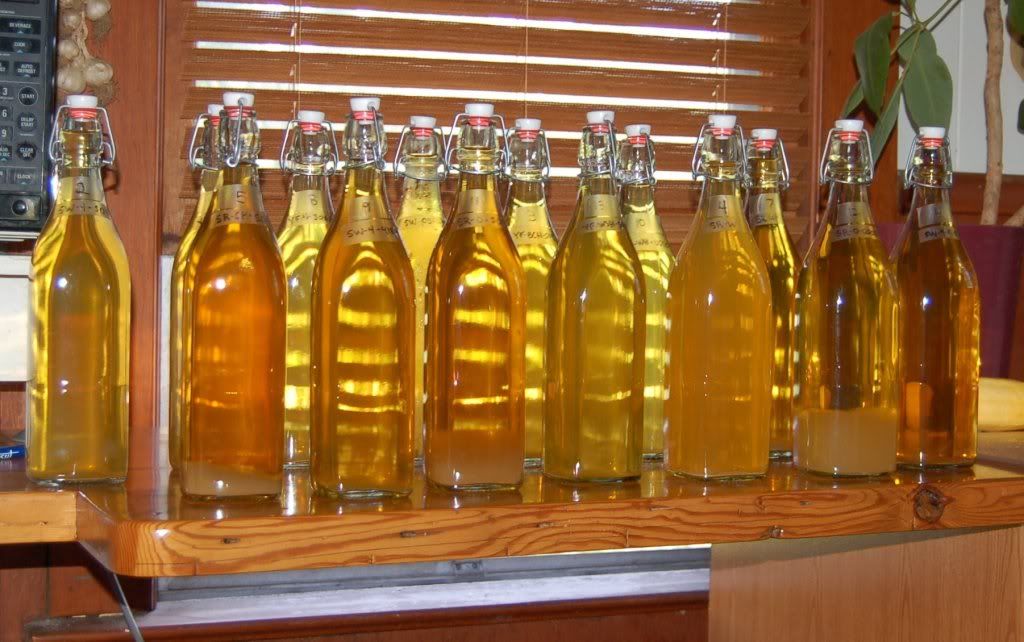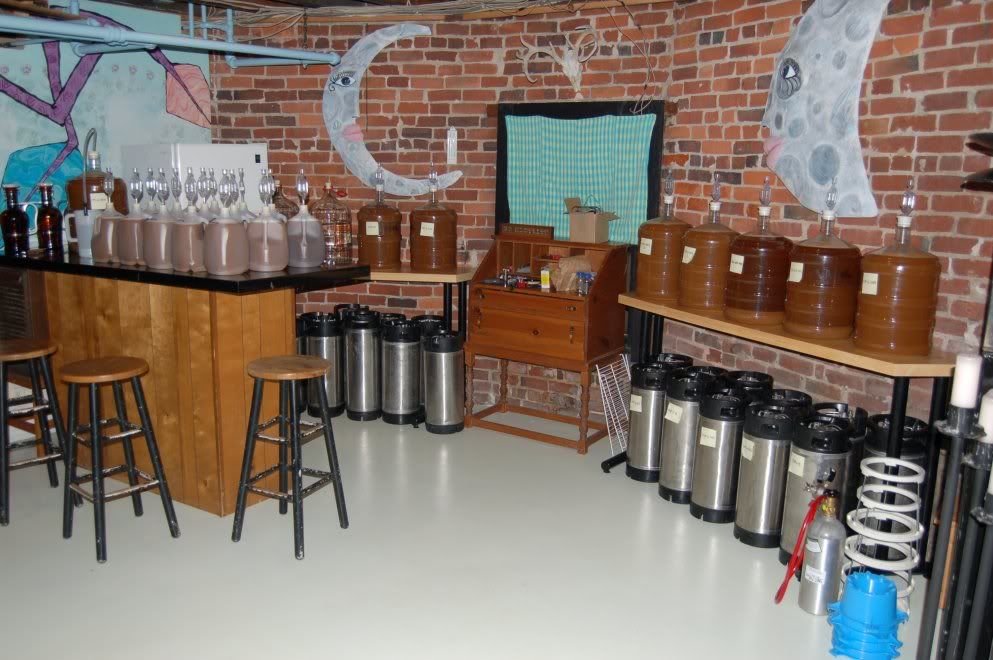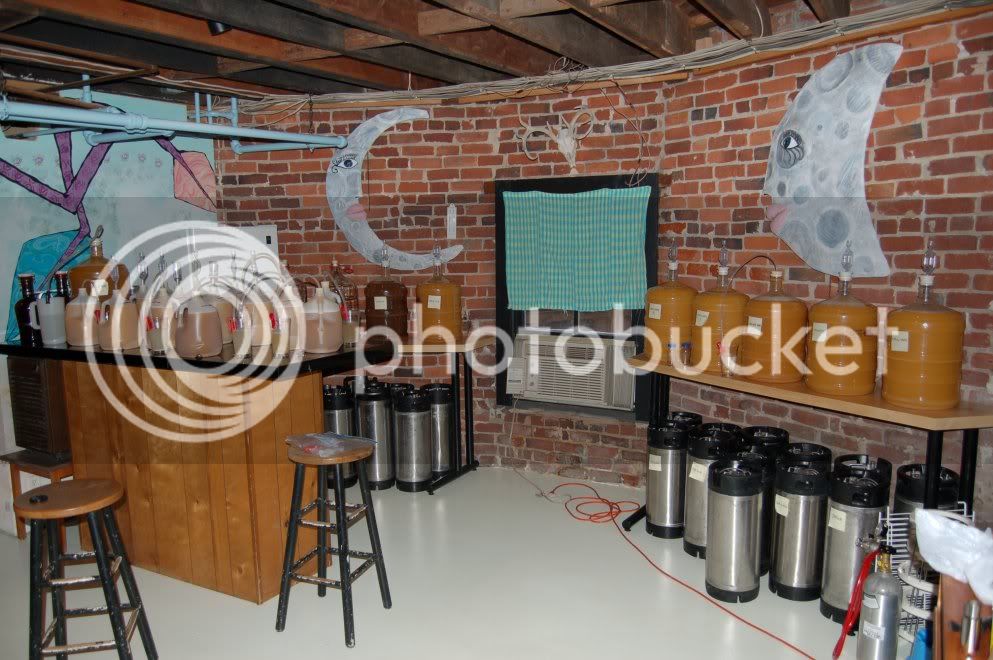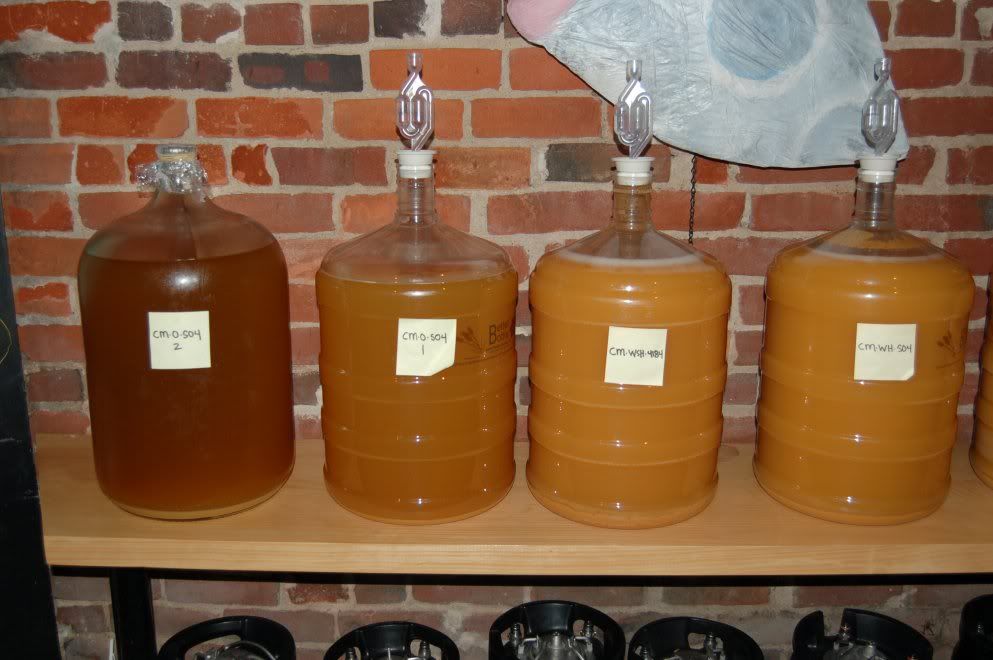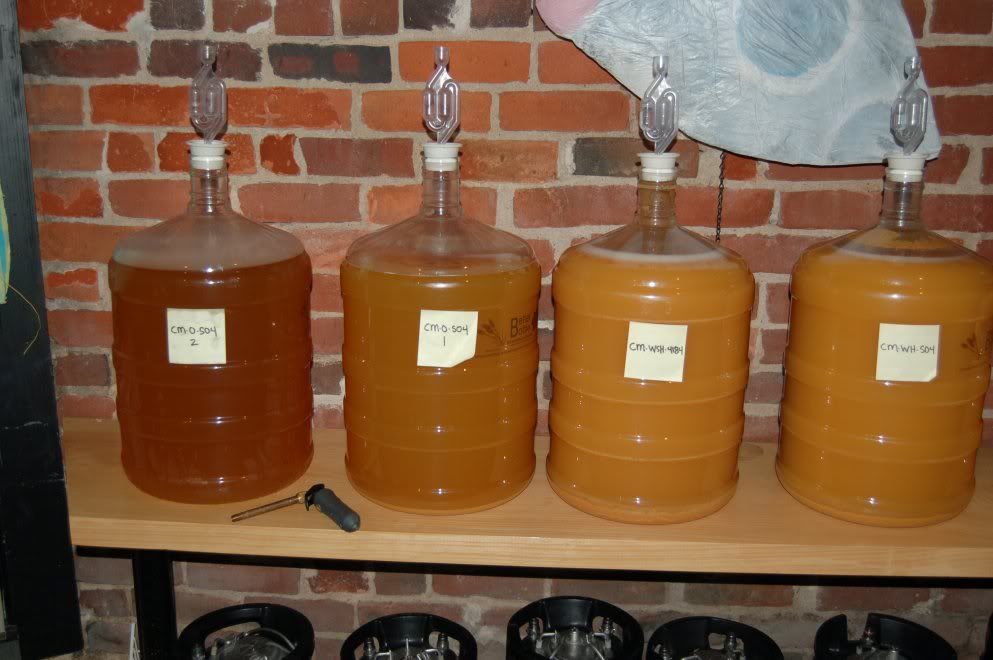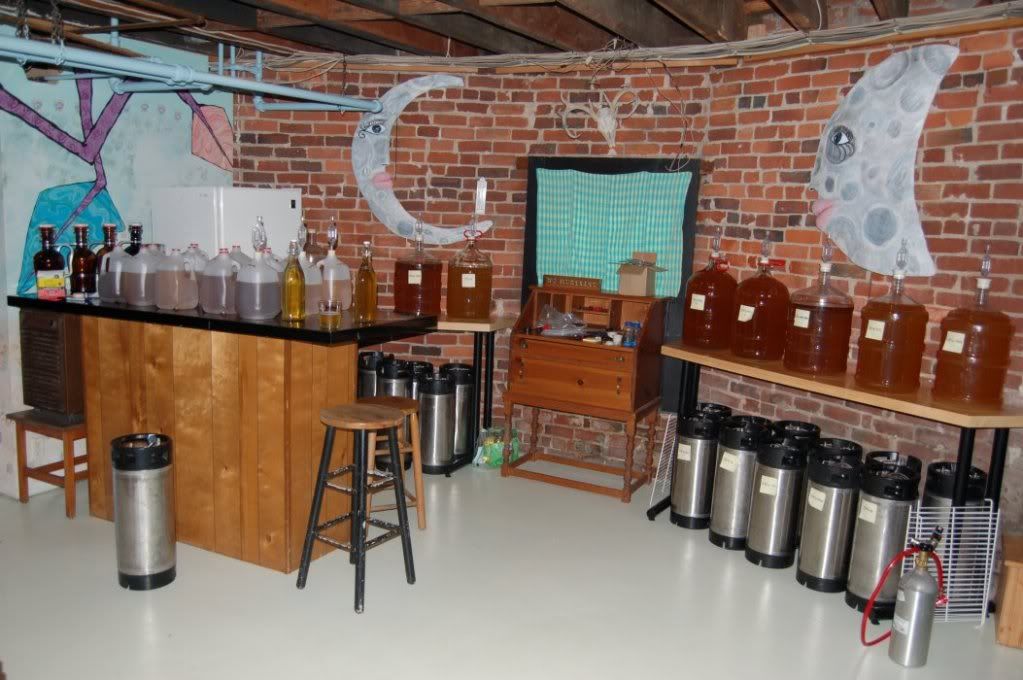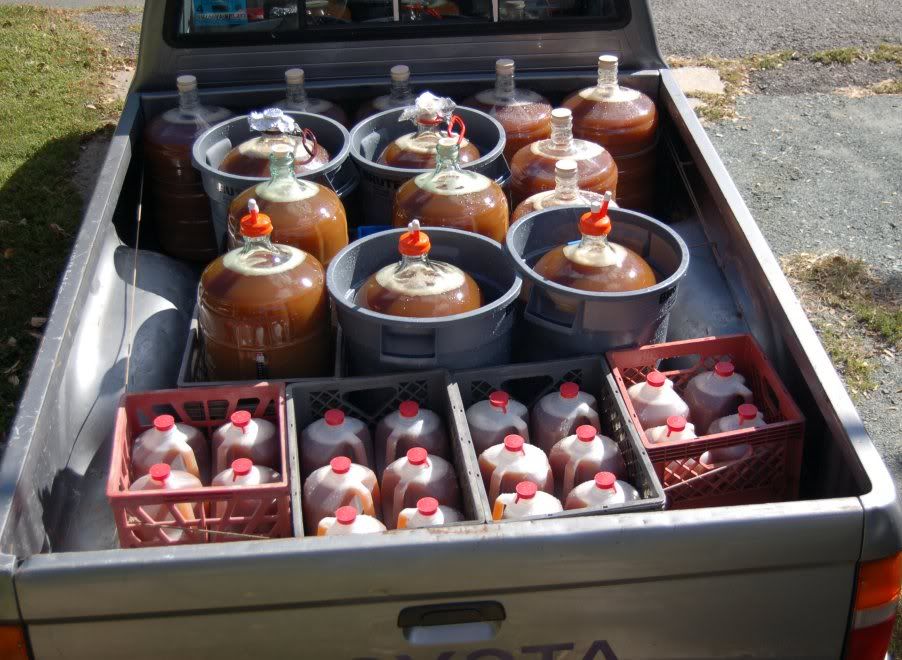CvilleKevin
Well-Known Member
Last night some friends came over and we polished off another 13 liters of various batches Seven with wild yeast and five with various other yeasts.
The overall favorite was a bottle of farmhouse cider made by the guy who runs the press where I get most of my juice. He gave me a couple of liters at the beginning of the year, from a barrel that they let ferment naturally in one of the sheds. It was a mix of Staymans and Winesaps and at the time was very sweet sg of 1.030 when I drank the first liter. The second liter has been sitting in my fridge since January. It must have continued to carbonate in the fridge because it popped and started foaming hard as soon I opened it. I had to snap the top back on to keep it in the bottle. My guess is that the SG dropped at least another 5 points or so while it was in the fridge. Fortunately it didnt crack the bottle. It tasted a lot like a JK Scrumpy. Distinct natural yeast taste, fairly sweet, but not overly so.
Just behind the farmhouse cider, rating-wise, was another wild yeast cider - a keg batch I made last Fall, from Staymans and Romes, pressed Nov 24. The SG was 1.064 and I crashed it on Dec 19 at 1.014. It wasnt quite as sweet as the farmhouse more like a Samuel Smith than a JK Scrumpy. Some folks like it better because it wasnt so sweet, but on average the farmhouse batch scored a little higher.
Number three, and my personal favorite of this round, was from the same Stayman/Rome batch, no extra sugar and S04 yeast. Crashed at 1.010 on Dec 20. I left it in the secondary until March 12, hoping it would clear, but it never did. The two liters I pulled from the keg finally did clear. Its probably more accurate so say they are still in the process of clearing. Most of the bottle was clear as a bell, with about an inch of sediment on the bottom that hasnt compacted yet. Overall, it was nice and crisp with great apple flavor. Even the sediment tasted good.
Almost tied with the Staymans/Rome/S04 batch was a bottle of York and Fuji with Wyeast 3068 always a crowd favorite. I dont think it was quite as good as when it was in the keg and my girlfriend agreed. Still very drinkable, but maybe a little past its peak. I didnt put any k-meta in this batch, and its been almost 6 months since pressing, which might have something to do with the taste peaking.
The other ale yeast batches were mostly OK nothing to write home about though.
The other 5 wild yeast batches were interesting unfortunately not in a good way. These were all from single gallon batches, Staymans and Winesaps pressed on Oct 30 with sg of 1.50. I made three liters from each gallon. The first round was tasted in January (see page 7) and it was not all that great. Six months later the taste has changed somewhat, but not really gotten any better. These batches were the first time that I was able to get wild yeast to ferment down to 1.002 without picking up some sort of weird taste. However they dont have much taste at all, except for the two that I sorbated (which taste mostly like sorbate, even though I only used half the recommended dosage). The ones that I added the k-meta to had lost the k-meta bitterness, but not much else to take its place
The interesting thing is that the three that I cold crashed all started fermenting again. They were very well carbonated even though I bottled them still even the two that I added varying amounts of k-meta to. That would lead me to believe that wild yeast doesnt cold crash very well, especially since the only bottle Ive every burst was with a wild yeast batch last summer. However the Stayman/Rome wild yeast batch, mentioned above, crashed just fine. I kegged that batch at 1.014 in January and saved a couple of liters when I finished the keg in March. It wasnt any more carbonated than any of the other liters that I filled from kegs earlier this year. That make me wonder if for wild yeast, it is not just the cold crashing that stops the yeast, but cold crashing followed by kegging at 25psi. Im not sure why that would make any difference, but its the main difference I can think of. It could also be different wild yeasts, although the apples were all from the same orchard and press. Both mixes used Staymans and it seems unlikely that Winesaps and Romes would have different yeast on them, but maybe.
Im tempted to not touch the last bottle of Stayman/Rome wild batch and see if it eventually starts carbonating. But since its the last bottle and its good, Im more tempted to drink it soon, just in case it does burst. Next season Ill do more wild yeast keg batches so hopefully Ill have enough extra bottles at this time of the year that I can afford to sacrifice one or two to see what happens. On the other hand, Im going to let the last 5 Stayman/Winesap wild yeast bottles sit another 6 months. Since I bottled them at 1.002, I dont see how they could get much more carbed. If one does burst I wont have lost much, and the taste can only improve from here.
The overall favorite was a bottle of farmhouse cider made by the guy who runs the press where I get most of my juice. He gave me a couple of liters at the beginning of the year, from a barrel that they let ferment naturally in one of the sheds. It was a mix of Staymans and Winesaps and at the time was very sweet sg of 1.030 when I drank the first liter. The second liter has been sitting in my fridge since January. It must have continued to carbonate in the fridge because it popped and started foaming hard as soon I opened it. I had to snap the top back on to keep it in the bottle. My guess is that the SG dropped at least another 5 points or so while it was in the fridge. Fortunately it didnt crack the bottle. It tasted a lot like a JK Scrumpy. Distinct natural yeast taste, fairly sweet, but not overly so.
Just behind the farmhouse cider, rating-wise, was another wild yeast cider - a keg batch I made last Fall, from Staymans and Romes, pressed Nov 24. The SG was 1.064 and I crashed it on Dec 19 at 1.014. It wasnt quite as sweet as the farmhouse more like a Samuel Smith than a JK Scrumpy. Some folks like it better because it wasnt so sweet, but on average the farmhouse batch scored a little higher.
Number three, and my personal favorite of this round, was from the same Stayman/Rome batch, no extra sugar and S04 yeast. Crashed at 1.010 on Dec 20. I left it in the secondary until March 12, hoping it would clear, but it never did. The two liters I pulled from the keg finally did clear. Its probably more accurate so say they are still in the process of clearing. Most of the bottle was clear as a bell, with about an inch of sediment on the bottom that hasnt compacted yet. Overall, it was nice and crisp with great apple flavor. Even the sediment tasted good.
Almost tied with the Staymans/Rome/S04 batch was a bottle of York and Fuji with Wyeast 3068 always a crowd favorite. I dont think it was quite as good as when it was in the keg and my girlfriend agreed. Still very drinkable, but maybe a little past its peak. I didnt put any k-meta in this batch, and its been almost 6 months since pressing, which might have something to do with the taste peaking.
The other ale yeast batches were mostly OK nothing to write home about though.
The other 5 wild yeast batches were interesting unfortunately not in a good way. These were all from single gallon batches, Staymans and Winesaps pressed on Oct 30 with sg of 1.50. I made three liters from each gallon. The first round was tasted in January (see page 7) and it was not all that great. Six months later the taste has changed somewhat, but not really gotten any better. These batches were the first time that I was able to get wild yeast to ferment down to 1.002 without picking up some sort of weird taste. However they dont have much taste at all, except for the two that I sorbated (which taste mostly like sorbate, even though I only used half the recommended dosage). The ones that I added the k-meta to had lost the k-meta bitterness, but not much else to take its place
The interesting thing is that the three that I cold crashed all started fermenting again. They were very well carbonated even though I bottled them still even the two that I added varying amounts of k-meta to. That would lead me to believe that wild yeast doesnt cold crash very well, especially since the only bottle Ive every burst was with a wild yeast batch last summer. However the Stayman/Rome wild yeast batch, mentioned above, crashed just fine. I kegged that batch at 1.014 in January and saved a couple of liters when I finished the keg in March. It wasnt any more carbonated than any of the other liters that I filled from kegs earlier this year. That make me wonder if for wild yeast, it is not just the cold crashing that stops the yeast, but cold crashing followed by kegging at 25psi. Im not sure why that would make any difference, but its the main difference I can think of. It could also be different wild yeasts, although the apples were all from the same orchard and press. Both mixes used Staymans and it seems unlikely that Winesaps and Romes would have different yeast on them, but maybe.
Im tempted to not touch the last bottle of Stayman/Rome wild batch and see if it eventually starts carbonating. But since its the last bottle and its good, Im more tempted to drink it soon, just in case it does burst. Next season Ill do more wild yeast keg batches so hopefully Ill have enough extra bottles at this time of the year that I can afford to sacrifice one or two to see what happens. On the other hand, Im going to let the last 5 Stayman/Winesap wild yeast bottles sit another 6 months. Since I bottled them at 1.002, I dont see how they could get much more carbed. If one does burst I wont have lost much, and the taste can only improve from here.


